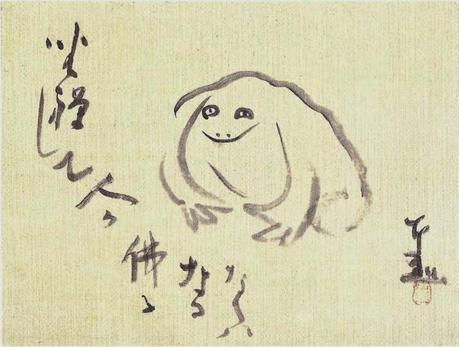
Meditating Frog by Sengai
It’s been five months since I was last here at Prana del Mar, the Ocean of Energy, an incredible yoga retreat center just north of Cabo San Lucas near the tip of the Mexican Baja Peninsula. When I was last here in December, I posted a few short meditations that some of you found useful (see Short but Sweet: 10-Minute Meditations), so I thought I’d continue the tradition and offer you another one to try today. For some of you, this particular meditation technique will be familiar, but for others it may be fresh and new. I don’t recall the first time a yoga teacher suggested it to me for my meditation focus, but it took a while for me to appreciate it fully. It is called the So Hum meditation, and Timothy recommended it as a meditation technique for beginners in his post Starting a Meditation Practice.Yoga tradition tells us that the So Hum meditation is based on the sounds of the in-breath and the out-breath, that is, the sound you might hear as you listen to your inhale is said to be the “so” sound (pronounced like “sow”) and the sound you might hear as you listen to your exhale is said to be the “hum” sound. I say “might” because I wonder if it sounded a bit different in the ancient Indian culture than it does to modern English speakers. After all, the English “cock-a-doodle-do” of the rooster is heard as the “quiquiriqui” in Mexico, and “cocorico” in France.
Fortunately, there is a deeper connection to the yoga philosophy and ancient Sanskrit language that I came across, which may intrigue you enough to consider using this sound mantra as you meditate. The “so” is actually “sa,” which is related to the word “sat.” “Sat” is sometimes translated simply as “that,” but it is often also said to refer to “reality” or “all that is” and shows up as part of the names of famous Indian teachers or gurus, like Satchidananda, to name a more modern luminary. And the “hum” comes from the word “aham,” which may be a shortened version of ahamkara, a term which refers to the ego-self, or our ordinary self, as opposed to our higher, spiritual self. That's right - in some yogic philosophies, we have multiple realities rolling around in our heads at the same time! Our ahamkara often holds the control of things over our wiser part, known as our buddhi consciousness, and a lot of the work of yoga is trying to shift that control over to our more enlightened potential. So when “sa” and “aham”(which here translates as “I am”) meet, they become “so” and “hum”, which could be translated as “I am that” or “I am Reality.” It is a reminder that we are interconnected and inseparable from all of reality.
An interesting aside is that Melina Meza (our YFHA photographer), who is here co-teaching with me, shared with our group yesterday is that in the Indian Life Science of Ayurveda, it is believed that disease’s first germination occurs because we have forgotten our interconnectedness with all of life. So, maybe this mantra is a way of reconnecting with that yogic truth. And wouldn’t it be great if it had a beneficial effect on reversing disease?
So I invite you to set yourself up in a comfortable seated position, either in a yoga pose, such as Hero pose or Simple Crossed Legs, or in a chair. Now find your inner lift from your sittings bones up to the crown of your head, and simply begin to listen to the sound of your own breath. Even is it does not sound exactly like “So Hum” as you inhale and exhale, hear those syllables in your mind with each round of breath for about 10 minutes. Practice once a day for the next week and see what you notice. Please report back to us any interesting observations you make! And for those of you interested in learning more about mantras and meditation, check out this interesting article The Power of Mantra from Yoga International that my good friend Sharon shared with me last week.

